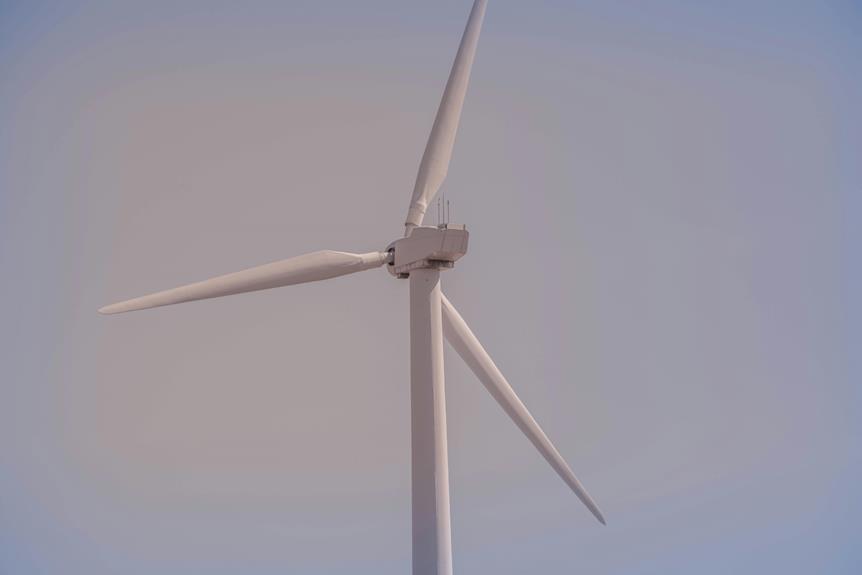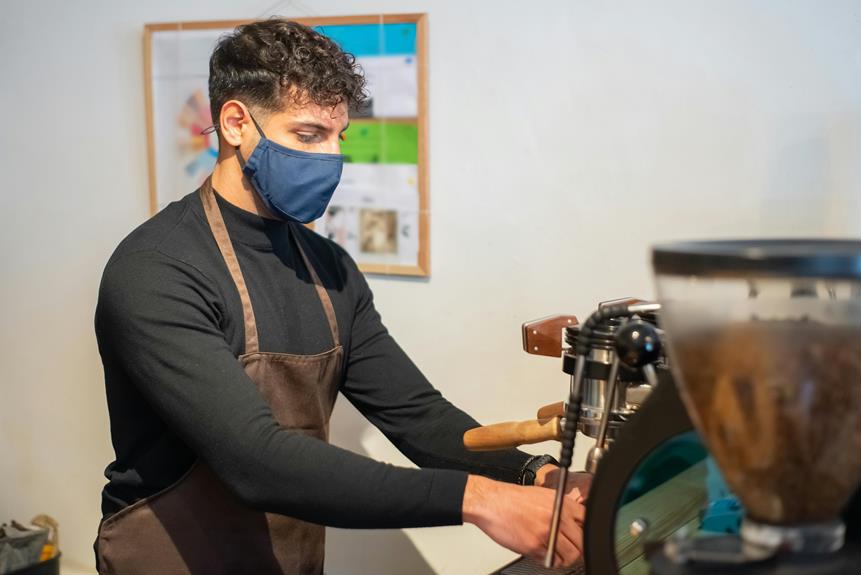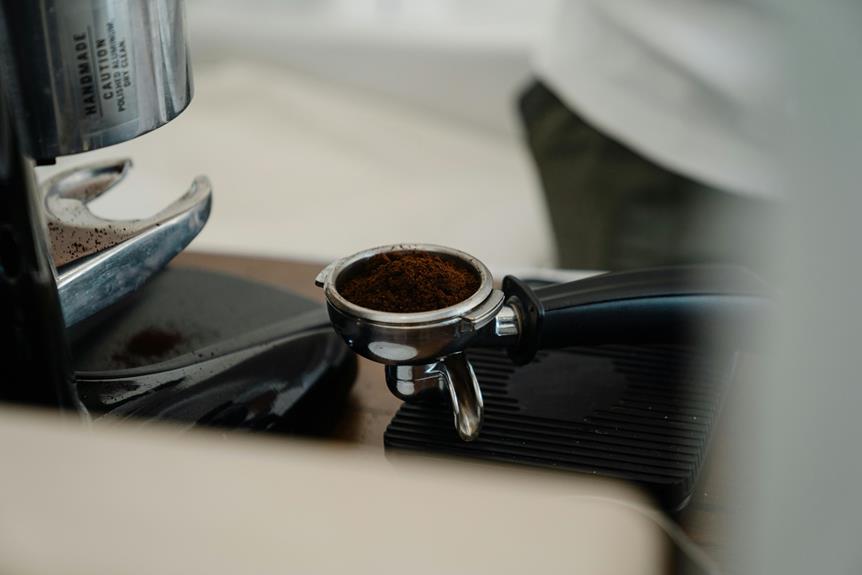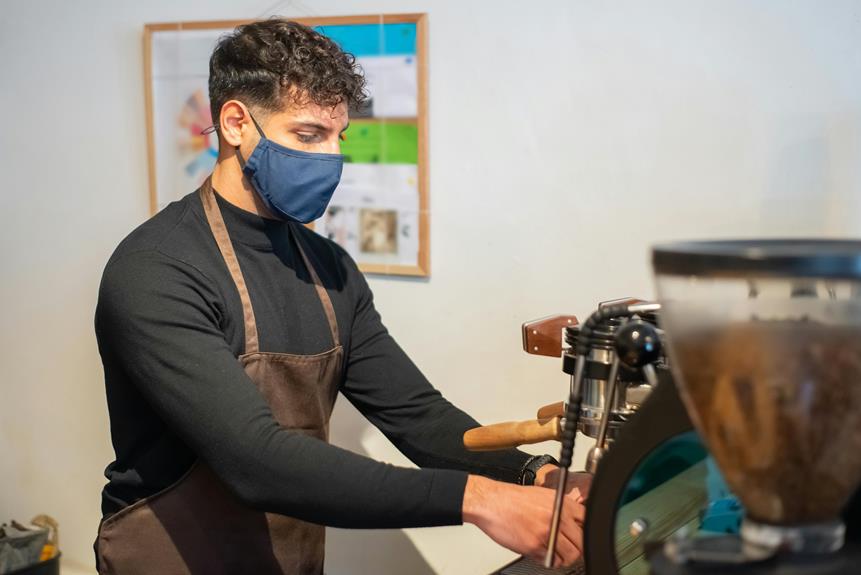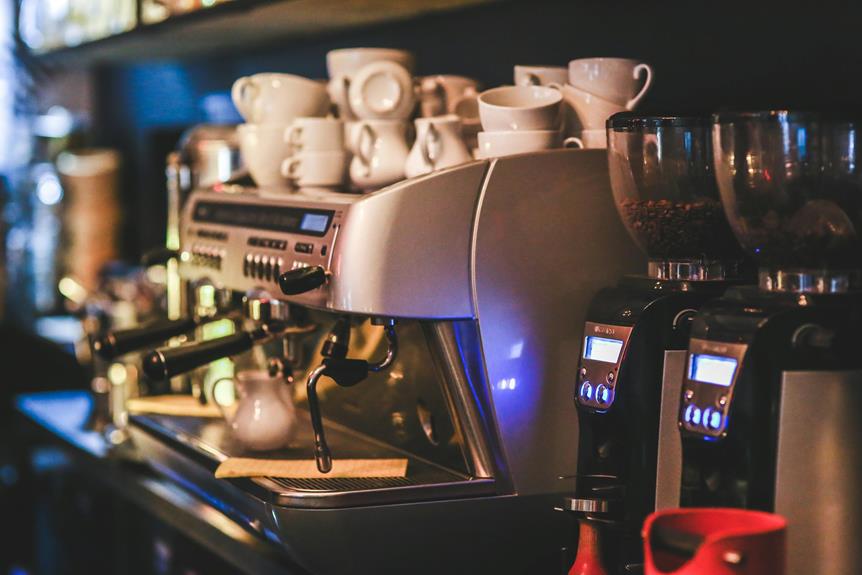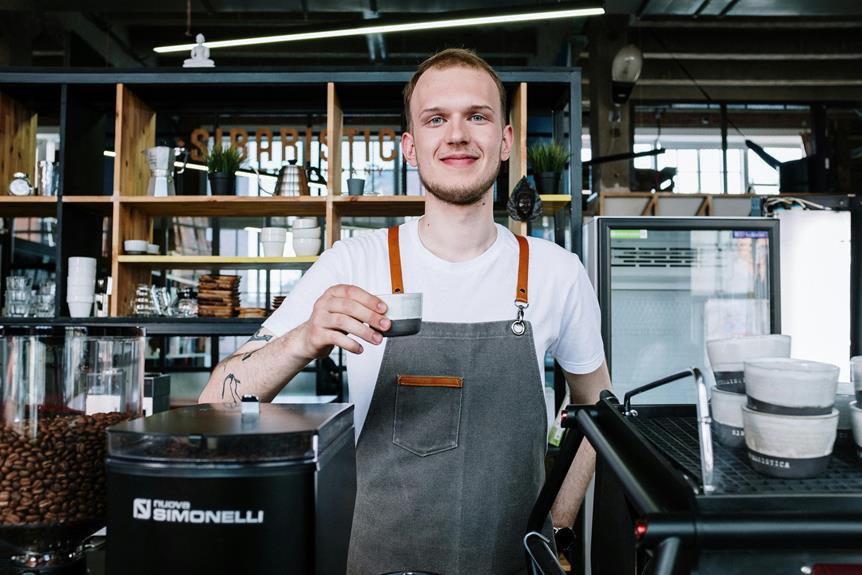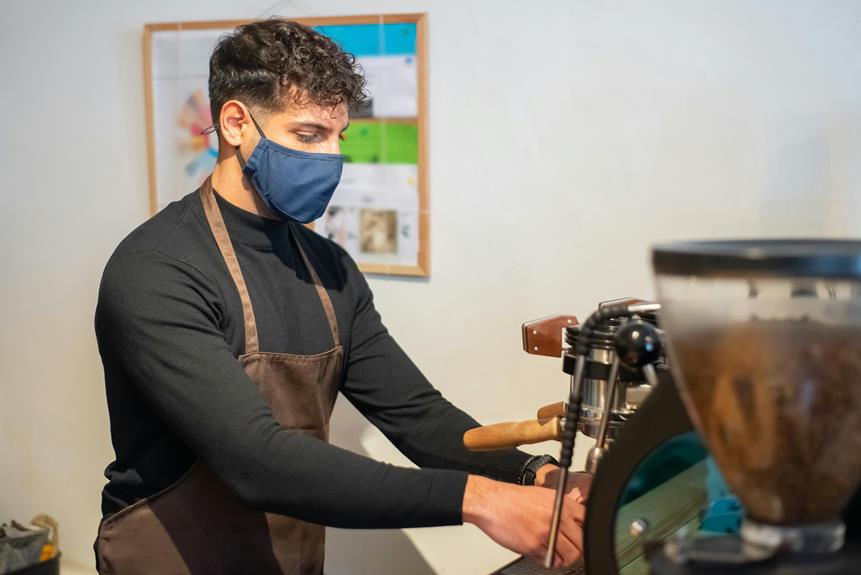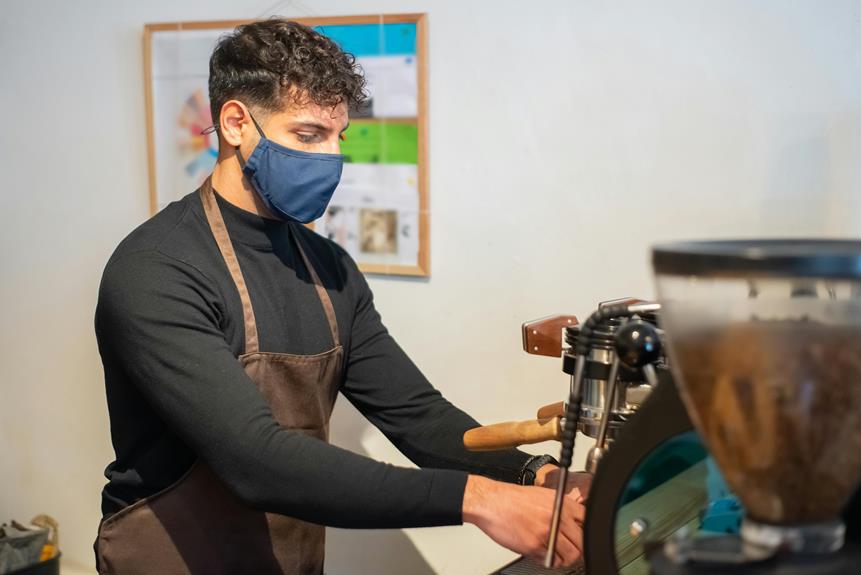When it comes to grinding your coffee beans, you've got two main options: burr grinders and blade grinders. Burr grinders use two abrasive surfaces to crush beans into a precise grind, ensuring consistency and flavor. Blade grinders, on the other hand, rely on a spinning blade to chop beans, generating heat and leading to inconsistent grinds and flavor loss. The difference is significant: burr grinders produce a more nuanced and flavorful cup, while blade grinders can result in a bitter taste. As you explore the world of coffee grinding, you'll discover the features that make all the difference.
Key Takeaways
- Burr grinders produce a consistent grind size, ensuring a balanced flavor, while blade grinders yield an inconsistent grind, affecting flavor profile.
- Burr grinders operate at a lower temperature, preserving coffee flavors and aromas, whereas blade grinders generate heat, leading to flavor loss and bitterness.
- Burr grinders have a precise mechanism with durable materials, guaranteeing a consistent grind, whereas blade grinders rely on a spinning blade, causing friction and heat buildup.
- Regular maintenance is crucial for both grinders, but burr grinders require less frequent cleaning and are more durable than blade grinders.
- Burr grinders are generally more expensive than blade grinders but offer superior quality, durability, and flavor preservation, making them a worthwhile investment for coffee enthusiasts.
Understanding Burr Grinder Technology
You're likely familiar with the concept of burr grinders, but have you ever stopped to think about how they actually work?
At the heart of a burr grinder lies a clever mechanism that involves two abrasive surfaces, or 'burrs,' that work together to crush your coffee beans into a precise grind.
These burrs are typically made from durable materials like stainless steel or ceramic, which are chosen for their ability to withstand the rigors of daily use.
The key to a burr grinder's success lies in its gear ratios, which determine the speed at which the burrs rotate.
A well-designed gear ratio guarantees that the burrs spin at the precise speed to produce a consistent grind.
Material selection is also critical, as it affects the flavor and aroma of your coffee.
The Science Behind Blade Grinders
Blade grinders rely on a spinning blade to chop coffee beans into smaller pieces, but this chaotic process is far from the precise grinding mechanism of burr grinders.
You might think that the high motor power behind these blades would produce a consistent grind, but it's actually the opposite. The intense spinning motion generates heat, which can damage the coffee beans and lead to a lack of flavor.
Additionally, the noise levels of blade grinders are notably higher than those of burr grinders, making them less desirable for early morning coffee routines.
As you use a blade grinder, you'll notice that the blades spin at incredibly high speeds, often reaching up to 20,000 rpm.
While this might seem impressive, it's actually a major contributor to the inconsistent grind size and heat buildup.
The blades also tend to create a lot of friction, which can cause the grinder to vibrate and make a racket.
Grind Consistency and Flavor
As you examine the output of a blade grinder, it's clear that the chaotic process yields a grind that's inconsistent in size and plagued by heat damage, which substantially impacts the flavor of your coffee.
The resulting grind is a mix of fine and coarse particles, making it difficult to achieve a balanced extraction.
This inconsistency affects the flavor profile, masking delicate notes and accentuating bitter tones.
You'll struggle to bring out the unique characteristics of your coffee beans, and the flavor nuances will be lost.
In contrast, burr grinders produce a consistent grind size, which allows for a more even extraction and a more balanced flavor.
The coffee profiles are more defined, with distinct flavor notes and aromas.
You'll be able to taste the subtle differences between coffee beans from different regions and roasters.
The consistent grind size also enables you to explore different brewing methods, revealing the full potential of your coffee.
With a burr grinder, you'll experience a more nuanced and flavorful cup, every time.
Heat Generation and Its Effects
During the grinding process, high-speed blades generate a significant amount of heat, which can quickly raise the temperature of your coffee beans, causing them to lose their delicate flavors and aromas.
As you grind your coffee, the friction temperatures produced by the blades can reach scorching levels, burning your beans and resulting in a bitter taste.
This heat generation is further exacerbated by motor loadings, which can cause the grinder's motor to work harder and produce even more heat.
In contrast, burr grinders operate at a much lower temperature, preserving the flavors and aromas of your coffee beans.
Because burr grinders use a slower, more gentle grinding process, they don't generate the same level of heat as blade grinders.
This means you can enjoy a more flavorful cup of coffee, without the bitter notes that come with heat-damaged beans.
Burr Grinder Maintenance Tips
Regularly cleaning your burr grinder is essential to maintaining its performance and preventing any buildup of old coffee oils and residue that can affect the flavor of your freshly ground coffee. You'll be surprised at how a little maintenance can go a long way in keeping your grinder in top shape.
Descaling regularly is important, as mineral buildup from water can affect the performance of your grinder. Make sure to descale it every 3-6 months.
Prevent clogs by cleaning out any residual coffee grounds from the grinder after each use to prevent clogs from forming.
Wipe down the grinder using a soft cloth to wipe down the exterior and interior of the grinder, paying special attention to any areas with visible buildup or stains.
Blade Grinder Cleaning Essentials
Cleaning your blade grinder frequently is essential to prevent old coffee oils and residue from affecting the flavor of your freshly ground coffee. You'll want to make it a habit to clean your grinder every week or two, depending on how often you use it.
To sanitize your grinder, start by unplugging it and letting it cool down. Then, use a small, soft-bristled brush to sweep out any loose coffee grounds from the grinding chamber and crevices. You can also use a small vacuum cleaner or a damp cloth to remove any remaining debris.
For tougher residue, mix equal parts water and white vinegar in the grinder and pulse it a few times. Let it sit for about an hour before rinsing it out with warm water. This will help break down any stubborn oils and residue.
When selecting a brush for cleaning, opt for one with soft, flexible bristles that won't scratch the grinder's surfaces. A small, angled brush is ideal for reaching into tight spaces. By following these simple steps, you'll be able to keep your blade grinder in top condition and guarantee a fresh, flavorful cup every time.
Choosing the Right Grinder
Choosing the Right Grinder
With so many grinder options available, you'll want to weigh, ponder, or reflect on your coffee-brewing habits, budget, and personal preferences when selecting the right one for your needs.
This careful deliberation will guarantee you find a grinder that meets your unique requirements and enhances your overall coffee experience.
Three key factors to ponder when choosing a grinder are:
- Budget Constraints: Set a realistic budget and stick to it. Burr grinders tend to be more expensive than blade grinders, but they offer superior quality and durability. Reflect on the long-term benefits of investing in a high-quality grinder.
- Personal Preferences: Think about the type of coffee you brew most often. If you're a French press or espresso enthusiast, a burr grinder may be the better choice. If you prefer a quick and easy grind for drip coffee, a blade grinder might suffice.
- Grind Size and Consistency: Decide whether you need a grinder that can produce a specific grind size or if you're okay with a more general grind. Burr grinders typically offer more precise control over grind size and consistency.
Frequently Asked Questions
Can I Use a Burr Grinder to Grind Spices or Nuts?
You can definitely use a burr grinder for spices or nuts, as it preserves their natural flavor profile. Experiment with different grinding techniques to achieve your desired texture, and enjoy the enhanced flavors in your recipes.
Are Blade Grinders Better Suited for Small Kitchens?
Do you really want to sacrifice precious counter space for a bulky grinder? You won't with a blade grinder, perfect for small kitchens where space efficiency and countertop management are key, making them a great fit.
Do Grinders Require Regular Sharpening or Replacement?
You'll be happy to know that most grinders don't require frequent sharpening, but you'll still need to perform regular Grinder Maintenance to keep them in top shape, with Sharpening Frequency varying depending on usage and type.
Can I Wash a Burr Grinder in a Dishwasher?
"Savvy shoppers, skip the dishwasher for your burr grinder's sake; instead, follow gentle grinder maintenance rituals to preserve performance and avoid compromising dishwasher safety, ensuring your daily grind remains a delightful, damage-free delight."
Are Manual Grinders a Good Option for Camping or Travel?
When you're planning a camping or travel trip, you'll appreciate the portability concerns of manual grinders, which are compact and lightweight, offering wilderness convenience and a fresh cup anywhere, anytime, without worrying about electricity or batteries.
Conclusion
You've weighed the pros and cons, and now it's time to make the cut.
Think of your coffee grinder as a key that reveals the flavor potential of your beans.
Choose the right one, and you'll be sipping on a symphony of flavors; choose wrong, and it's a discordant mess.
With burr grinders and blade grinders, the difference is like night and day – one is a precise conductor, the other a chaotic storm.
Which one will you choose to harmonize your daily brew?
